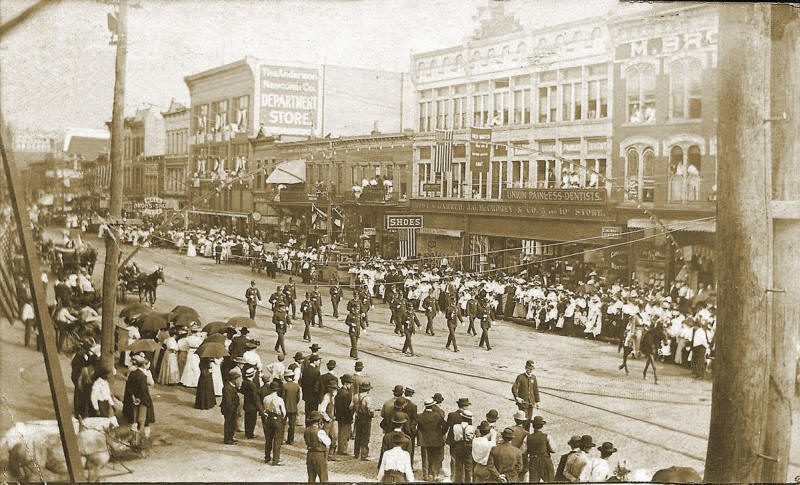
Veterans Visited Huntington in 1913
--------------------------------------------------------------------------------------------------

A marching unit makes its way down 3rd. Avenue in a parade
that highlighted the
1913 Huntington reunion of the Grand Army of the Republic.
--------------------------------------------------------------------------------------------------
HUNTINGTON — In 1913, a half century after the Civil
War, the city of Huntington welcomed hundreds of grizzled veterans of that
great conflict.
First, in May, West Virginia members of the Grand Army of the Republic, an
organization of Union veterans, conducted a reunion in the city.
Then, in October, their Confederate counterparts held a gathering of their
own.
After the end of the Civil War, various state and local
organizations were formed for veterans to network and maintain connections
with each other.
Founded in Illinois in 1866, the Grand Army of the Republic — often referred
to as the GAR — emerged as the largest and most influential such organization.
For many years, the GAR was a potent political force in its
efforts to secure pension increases and other benefits for veterans and their
dependents.
At its peak in 1890, it had more than 400,000 members and local posts in
nearly every state, even those in the South.
The organization ceased to exist in 1956 with the death of its last
member.
According to the West Virginia Encyclopedia, the first GAR
post in West Virginia was organized at Martinsburg in 1880.
By 1889, the organization had 3,161 members in 89 local posts throughout the
state. For many years the West Virginia GAR
members held an annual encampment somewhere in the state, and in 1913 a
May 20-22 event brought them to Huntington.
Newspaper stories before the gathering predicted the
gathering would bring more than 1,000 Union veterans to the city,
along with many members of the group’s Ladies Auxiliary. Although the news
account never reported a final number,
the actual attendance apparently proved to be only a fraction of that
optimistic prediction.
The visiting veterans, who arrived by train from all parts
of the state, found virtually every building in the
downtown business district either flying the nation’s flag or draped in red,
white and blue bunting.
Headquarters for the three-day event was the Elks Club,
while the Ladies Auxiliary met at the Florentine Hotel.
At their opening session at the Elks Club, the veterans were welcomed by Mayor
Floyd S. Chapman,
who praised their war-time service, saying: “We are constantly reminded that,
in the nation’s hour of peril,
you bared your bosoms to the leaden storm, and cheerfully risked your lives in
the country’s cause.”
A highlight of the gathering was a grand march, which saw
many of the oldest veterans not march but instead ride in motorcars
that had been volunteered for their use. “To have the veterans parade … in
automobiles was an entirely novel idea
and it is believed established a precedent,” reported The Herald-Dispatch.
After voting to meet the following next year in Moundsville, the Union veterans adjourned and entrained for their homes.
Later that same year, on Oct. 9 and 10, downtown Huntington
was “invaded”
by nearly 200 members of the United Confederate Veterans of West Virginia.
Just as he had done for the visiting Union veterans, Mayor
Chapman welcomed those who had worn Confederate gray.
“In selecting Huntington as your meeting point you have selected wisely,”
Chapman said, “If it has even been your ambition
to own a town for a few days before death shall have taken you, your
ambition is now gratified for the town is yours.”
Like the Union veterans, the Confederate vets conducted
their business sessions at the Elks Club.
A reception at the Fifth Avenue Hotel highlighted the convention’s social
activities.
A march through the city’s downtown marked the close of the
convention.
The Huntington Advertiser described the parade:
“Marching slowly and sometimes with faltering steps, the
veterans of the Confederate army passed through the streets of
Huntington today in what, as many who watched them sadly thought, would likely
be their last appearance as a body here.”
Yet, despite their advanced years, at the end of their route
the marchers were able to
raise their voices in the famous rebel yell that once was their battle
cry.
-----------------------------------------------------------
Note: This Article and picture appeared in the Herald-Dispatch Newspaper on Feb. 20 , 2016
-----------------------------------------------------------
[ Back ]